We took a day trip to the Florida Everglades a few weeks ago. To be factual, we went to the Shark Valley part of the Everglades. It's named so because it runs into Shark Lake which derived its name from the sharks that used to live in it; a form of shark that can live in either salt or fresh water (a Bull Shark).
The Everglades is a National Park in the US state of Florida that protects the southern 25% of the original Everglades. It is the largest sub tropical wilderness in the US and is visited each year on average by one million people each year. It is the third largest national park in the lower 48 states after Death Valley and Yellowstone. Unlike most U.S. national parks, it was created to protect a fragile ecosystem instead of safe guarding a unique geographic feature. It is home to 36 species designated as endangered or protected, including the Florida Panther, the American Crocodile and the West Indian Manatee. It is also the most significant breeding ground for tropical wading birds in North America. More then 350 species of birds, 300 species of fresh and saltwater fish, 40 species of mammals and 50 species of reptiles live within the Everglades.
In 1882 the region began to be drained for residential and agriculture use. In the 20th century the natural water flow from Lake Okeechobee was controlled and diverted to the explosive growth of the South Florida metropolitan area. The park was established in 1934 to protect the quickly vanishing Everglades and dedicated in 1947, the same year massive canal- building projects across South Florida began to divert water away from the park. The ecosystems in Everglades National Park have suffered significantly
from human activity and the repair and restoration of the Everglades is a politically charged issue in South Florida.
One example of man creating problems for himself is the Melaleuca tree which was imported from Australlia. This tree has the ability to soak up great amounts of water and was planted in the area to help soak up water and help with the establishing of land suitable for residential and agriculture purposes. It was planted in the Everglades originally to drain water from was thought to be a river.
Later it was realized that the Everglades is a large swamp. But it was too late. In fifty years the tree has grown to be a great nuisance in Florida especially in the Everglades. The tree grows to immense forests in the Everglades and its surrounding wetlands. Now there is a lack of water in the area and the trees keep growing and threatening the very existence of the Everglades.
Scientists are trying to discover a way to control the growth of the trees. Herbicides are somewhat effective but fires that they are purposely starting are actually helping to spread the tree's seeds. Recently scientist have released biologically controlled insects to help in the fight against the tree. I don't know about you but this does not fill me with hope!! We really are our the enemy!! The trees have consumed most of the Everglades Swamp and is threatening the existence of the swamp and its magnificent ecosystem.
When we arrived at Shark Valley we parked our car and walked over to a few buildings. We purchased tickets for a tour of the area on a tram with a park ranger as a guide. We would highly recommend taking this tour if you visit. As we were waiting for the next tour we walked over to a small river. When we looked down into the river it was obvious that we were in the Everglades. In a very small stretch of water were alligators, wading birds and fish swimming around. We saw alligators swimming up and down the river while others were near the shore almost hidden in the vegetation.
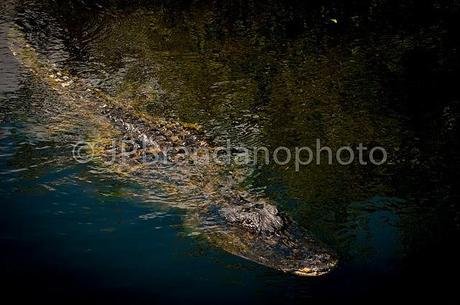
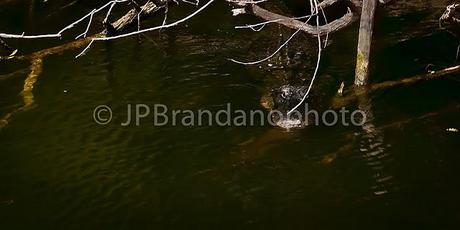
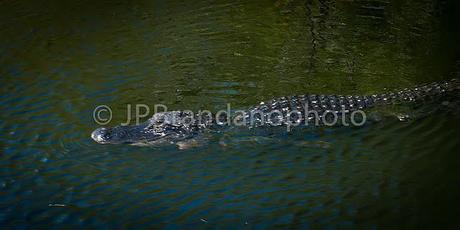
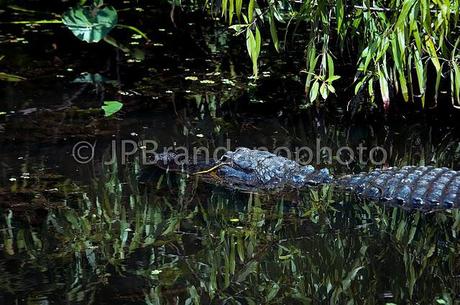
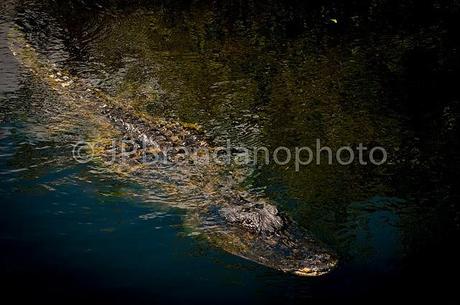
I find these creatures amazing to observe; seemingly sleepy and unfazed by what is around them but if something they perceive as food gets anywhere near them, you see their large eyes open and lock on to the target. They seem like something left over from another period of time. It is believed there are over 1.3 million alligators in Florida. That census is derived by determining the amount of suitable habitat and the average density of alligators in that habitat. To try and actually count the alligators would be time consuming, expensive and relatively dangerous.
One of the birds that live in the Everglades in the Anhinga, a water bird. It does not have oil glands for water proofing its feathers like most water birds. When it goes fishing its feathers get wet. This helps it dive and chase fish under water. However, when it is above water it must spread its wings to dry in the sun. It can fly with wet feathers but not as well. The Anhinga spears its prey with its pointed beak like an arrow. Sometimes the thrust is so powerful that it needs to swim to shore and pry the fish off its beak by rubbing the fish against a rock.
As I walked up the river I saw something under the murky water. First all I saw was the fan tail and I had no idea what it was. Then in a matter of seconds I saw the rest of the Anhinga swimming around under water looking for food. In this image you can see it underwater swimming around. It is really amazing to see this large bird swimming under water.
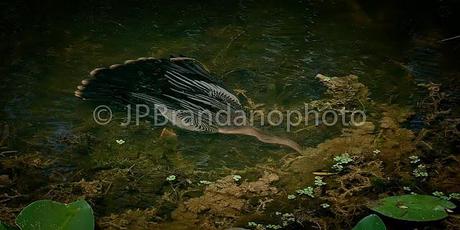
After a short time it came closer to the top and stuck its head out of the water to breath.

About 10 minutes later it surfaced and went on shore spreading its wings to dry in the sun.
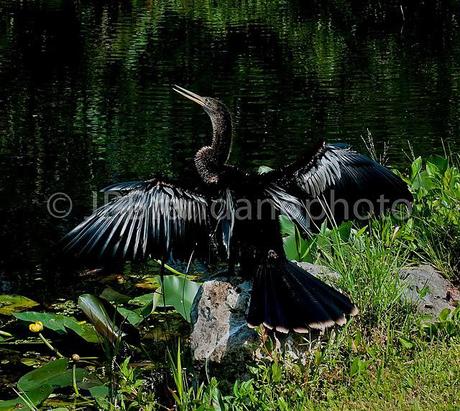
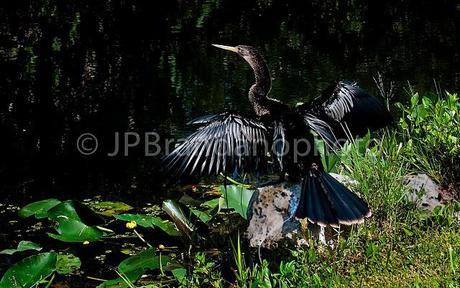 About 25 feet from the Anhinga I spotted a Blue Heron in the river.
About 25 feet from the Anhinga I spotted a Blue Heron in the river.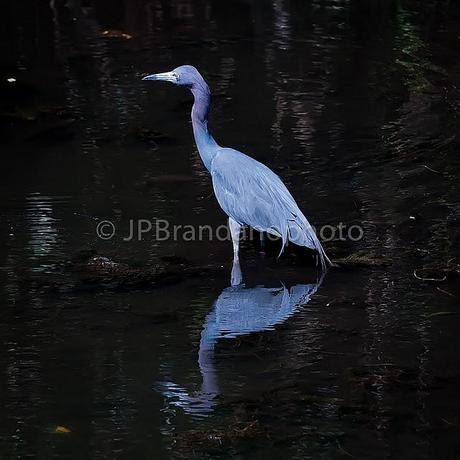
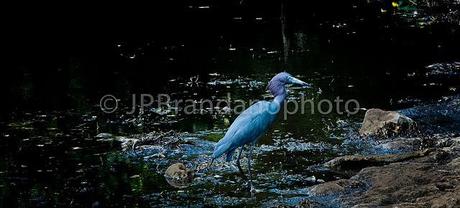
 A really beautiful bird!
A really beautiful bird!Even in this river you could see part of the different ecosystems.
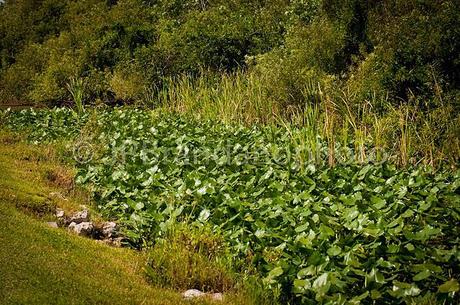
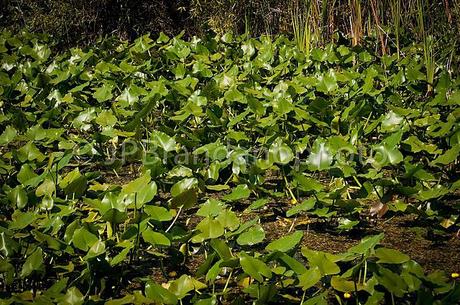 But be careful, in this lush vegetation lurks danger!!
But be careful, in this lush vegetation lurks danger!!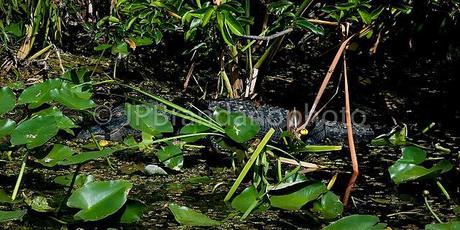

Soon it was time to get on the tram for our tour. Here's a tip if you're looking to take pictures. When you take your seat sit on the left (when looking to the front). There seemed to be more opportunities to photograph some on the inhabitants on that side. Phyllis sat there. I sat on the right!!!
Our next post will include images from our tram ride through the Florida Everglades.
( I need to give credit for part of the title of this post "we have met the enemy....... It is a line from an American cartoon. Pogo that ran for many years written by Walt Kelly. He penned the line many years ago and used it on a Earth Day Poster)

